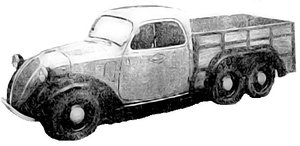Difference between revisions of "Ollearo"
m |
m |
||
| Line 1: | Line 1: | ||
{{X}} | {{X}} | ||
| + | |||
| + | |||
| + | == 1922 - 1952 == | ||
Revision as of 11:39, 14 December 2009
1922 - 1952
Ollearo, founded by Naphtali Ollearo and began in Turin in 1922 in a small workshop was equipped to repair bicycles and motorcycles, this activity was supported by his younger brother Mark who was an expert in building frames and valid racing driver. At that time Italy was troubled by a severe political and financial situation and motor trikes or "autociclette" as they were called, were popular among the people because they were the most economical means of transport.
In Italy there were already many brands that advertise their products in various ways, then Naphtali entered a market saturated with other brands and needed to present a business plan at a high technical level, to attract the attention of "afficionados" and obtain consent press in the industry. The genius of Ollearo jumped into the limelight since its first realization exhibited at the Show of Fine Arts in Turin in the winter of 1922. They built a scooter in record time with sophisticated engineering, was presented mounted on a bicycle frame and reinforced appropriately modified to accommodate a small engine connected to a direct drive to the rear wheel with a belt. The vehicle attracted much interest, so Ollearo decided to change the whole transmission system and to create an engine range and a special transmission.
And so, in 1923, began the Fabbrica biciclette a motore Ollear. After the success of the construction of step motor bikes with 2 speeds, always received a lot of success. Towards the thirties are the manufacturer engaged in the testing of Piedmont's new 4 stroke engine, so critics said that the new creation would be the new engine of tomorrow.
After this huge success he had with of motion Loose step, began building momentum with the construction of box vans of various types. In 1933 the brilliant builder from Turin made a three-wheel vehicle to transport people with the chassis of the truck and a 500 cc motorcycle engine. It was even equipped with reverse gear and a body like a torpedo convertible. Inside, the driver sat in front while the two passengers were placed on a single seat behind the driver, the frame was in the shape of a turtle shell. The vehicle could reach a speed of 90 km/h. The car, with wheel centers forming an equilateral triangle, had remarkable stability so that if you accidentally went to skid which tends to turn on itself, there was no danger of rolling over. Presented at the exhibition in Turin in 1934, the vehicle created quite a stir, so much so that Ollearo planned to improve the body. The vehicle was clothed in a new shell and the result was of harmonious lines and more acceptable, so that it gave the impression of being a real car with four wheels. The purchase price was 8000 pounds and you could drive without a drivers license and the road tax was identical to that of a motorcycle.
Due to Ollearo's enormous success, was approached by Fiat, which commission him to turn the Fiat Topolino 500 series cars into drive vans and trucks. The Ollearo truck began production in 1937 in Torino and worked under the supervision and with the blessing of the Reparto Esperienze (Expertize Department) at Fiat. Ollearo put out an incredible three-axle truck built on a Fiat 500A. The vehicle was unchanged until the upright rear doors were added where the body ended and the chassis frame overlaped. The longitudinal steel was electrically welded to move the bridge rearwards by 23cm and added an additional axle, not driven by the engine, but only as a carrier axle. They were a relatively widely used truck, and remained in production even after the Fiat 500B and Fiat 500C were introduced. This continued until 1952, when it completely ceases production. True story of a man who with thirty years of business had been able to, with his brilliant mind of talented designer and builder, give ideas to the Italian avant-garde, producing engines and technical advancements still in use today.
ENGINE: 500 cc displacement., Valves in head tilted, rocker enclosed in box, valve protected. SPEED CHANGE ': four gears, and reverse acting with the engine block. SUSPENSION: rear axle suspended on leaf springs, hydraulic shock absorbers. GENERAL FEATURES: maximum speed 90 kilometers per hour, average 65 km per hour; gasoline consumption: 1 liter every 19-20 km. Scope 3 people with a maximum of 500 kg.
Send what you have to:
| Car Information and Photos by Marque: A - B - C - D - E - F - G - H - I - J - K - L - M - N - O - P - Q - R - S - T - U - V - W - X - Y - Z |
| Motorcycle Information and Photos by Marque: A - B - C - D - E - F - G - H - I - J - K - L - M - N - O - P - Q - R - S - T - U - V - W - X - Y - Z |
